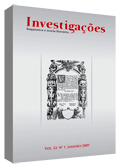Atos de autoria:assinaturas, rasuras, rupturas
Abstract
Este ensaio é um confronto entre algumas teses em torno da noção de autor, tendo como pano de fundo o problema do ato de fala. Para isso, a IX Conferência, de Austin (1976), e o texto Assinatura, acontecimento, contexto, de Derrida (1990), são confrontados, e esse confronto é relacionado com as noções de sujeito implicadas no texto de Barthes (1987) sobre o autor, e no texto sobre o narrador de Benjamin (1983).References
AUSTIN, J. L. 1976. How to do things with words. 2ª ed. Oxford: Oxford University Press.
BARTHES, Roland. 1987. A morte do autor. In: O rumor da língua. Lisboa: Edições 70, pp. 49-53.
______. 2002. O prazer do texto. 3ª ed. São Paulo: Perspectiva.
BENJAMIN, Walter. 1983. O narrador. In: Textos escolhidos. São Paulo: Abril Cultural, pp. 197-221.
DERRIDA, Jacques. 1998. Carta a um amigo japonês. In: OTTONI, Paulo (org.). Tradução: a prática da diferença. Campinas: Editora da Unicamp, pp. 19-25.
______. 1990. Signature événement contexte. In: Limited Inc. Paris: Éditions Galilée. pp. 15-51.
PINTO, Joana Plaza. 2004. Algumas lições sobre o corpo. Anais do II Encontro Nacional do GELCO (Grupo de Estudos da Linguagem do Centro-oeste): Integração Lingüística, Étnica e Social, Brasília, v. II, pp. 583-588.
Downloads
Published
How to Cite
Issue
Section
License
Copyright (c) 2009 Joana Plaza Pinto

This work is licensed under a Creative Commons Attribution 4.0 International License.
Authors who publish with Revista Investigações agree to the following terms:
Authors retain copyright and grant the journal right of first publication with the work simultaneously licensed under the Creative Commons Attribution 4.0 International (CC BY 4.0) license that allows others to share the work with an acknowledgement of the work's authorship and initial publication in this journal.
Authors are able to enter into separate, additional contractual arrangements for the non-exclusive distribution of the journal's published version of the work (e.g., post it to an institutional repository or publish it in a book), with an acknowledgement of its initial publication in this journal.
You are free to:
Share — copy and redistribute the material in any medium or format for any purpose, even commercially.
Adapt — remix, transform, and build upon the material for any purpose, even commercially.
The licensor cannot revoke these freedoms as long as you follow the license terms.
Under the following terms:
Attribution — You must give appropriate credit , provide a link to the license, and indicate if changes were made . You may do so in any reasonable manner, but not in any way that suggests the licensor endorses you or your use.
No additional restrictions — You may not apply legal terms or technological measures that legally restrict others from doing anything the license permits.

